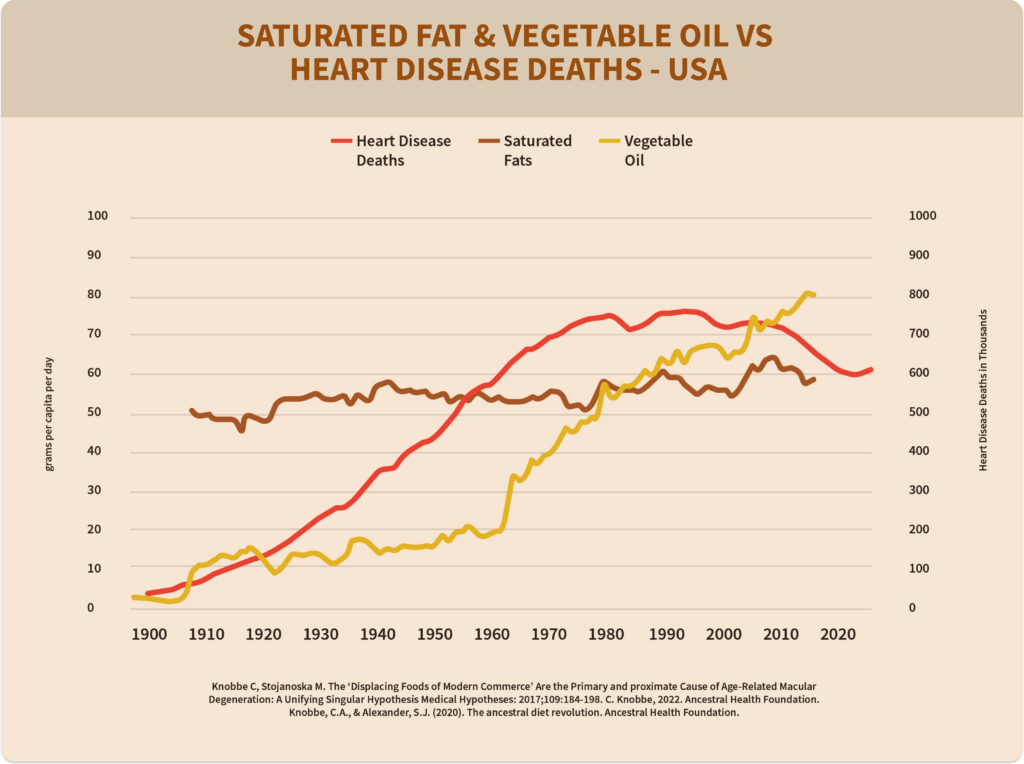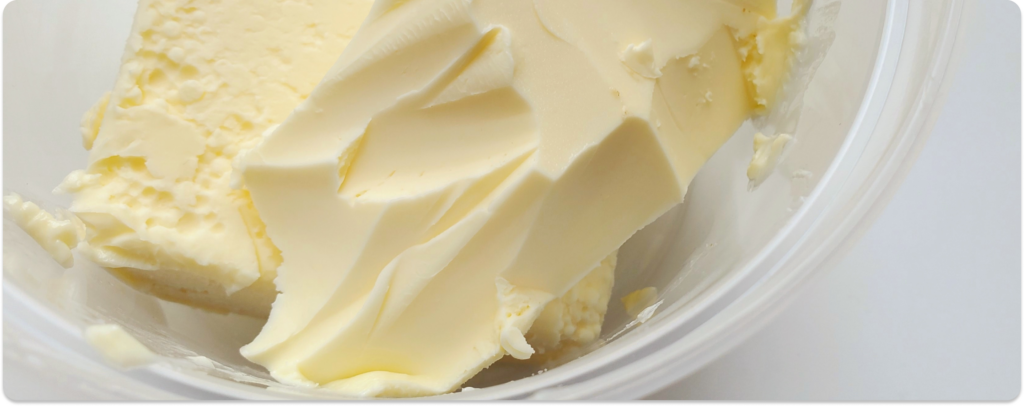PLEASE NOTE: The information in this blog is for educational purposes only. It is not a substitute for professional medical advice. Consult your healthcare provider if you’re seeking medical advice, diagnoses, or treatment.
Butter has been a staple in kitchens worldwide for centuries, but the question, “Is butter a healthy fat?” has sparked intense debate over the years.
For decades, butter was unfairly vilified due to its saturated fat content, primarily influenced by a flawed hypothesis that linked saturated fat to heart disease. This shift led many to replace butter with industrial seed oils, dramatically altering dietary habits for generations.
In this post, we’ll explore the science behind butter’s composition, uncover the history of its controversial reputation, debunk common myths about saturated fat, and explore its nutrient profile to help you answer the question, “Is butter a healthy fat?”
What is Butter?
Butter is a natural dairy product created by churning cream until the butterfat particles clump together, forming a rich, solid mass of about 80% fat (1). The remaining buttermilk is drained away.
Butter has been cherished for thousands of years, dating back to ancient agricultural societies around 8,000 BCE when agricultural societies began domesticating livestock and experimenting with dairy. Culture highly valued it for its use as food, medicine, and even in ceremonies (2).
For example, Romans used butter to treat burns, skin conditions, and wounds. In Northern European cultures, such as the Norse, butter symbolized wealth and abundance. It was essential to their diets, especially during long, harsh winters when fresh food was scarce.
Even though butter has been a natural staple for ages, modern diet trends have made people question if butter is a healthy fat. Let’s uncover the truth about butter and saturated fats.

Are Butter and Saturated Fats Healthy?
Butter’s reputation took a significant hit in the 1950s, mainly due to the flawed “diet-heart hypothesis,” which linked saturated fat to heart disease. Researcher Ancel Keys claimed that saturated fat raised cholesterol levels, which clogged arteries.
Despite weak evidence, institutions like the American Heart Association recommended replacing saturated fat intake with polyunsaturated fatty acids (PUFAs) derived from industrial seed oils like soybean oil.
Unfortunately, the shift away from natural fats like butter coincided with a drastic rise in heart disease and other chronic illnesses, suggesting that the advice was misdirected.

Modern research has debunked the diet-heart hypothesis. Since the 1960s, over 20 studies have shown no strong evidence connecting saturated fat consumption to cardiovascular disease (3). These studies highlight the diet-heart hypothesis’s oversimplification, which ignored the complexity of cholesterol metabolism and the body’s overall nutrient needs.
While saturated fats may raise LDL cholesterol, this isn’t inherently harmful. LDL is vital in transporting fat-soluble vitamins to cells for hormone production, cell repair, and other critical functions.
LDL issues arise not from saturated fat but from oxidation, often caused by dietary factors, mainly the overconsumption of seed oils.
Far from being a dietary villain, saturated fat supports fundamental processes that keep your body thriving.
Which is Healthier: Butter or Seed Oils?
The differences in composition, processing, and health impact are stark when comparing butter to seed oils.
Seed Oils
Composition: Seed oils such as canola, sunflower, and soybean are high in polyunsaturated fatty acids (PUFAs), particularly omega-6. While omega-6 fatty acids are essential in small amounts, modern diets are overabundant, disrupting the delicate omega-3 to omega-6 balance. This imbalance can promote chronic inflammation, a factor in heart disease, diabetes, and autoimmune conditions (4).
Processing: Seed oils undergo heavy industrial processing, including refining, bleaching, and deodorizing, which strips away many natural nutrients and introduces oxidized fats. These fats are highly unstable and can generate free radicals, contributing to oxidative stress and cellular damage in your body.
Health Risks: Studies have linked excessive PUFA consumption from seed oils to systemic inflammation, poor metabolic health, and an increased risk of chronic diseases, making them a poor choice for long-term health.
Butter
Composition: Butter is predominantly saturated fat, making it stable, heat-resistant, and less prone to oxidation. This stability makes it ideal for cooking, as it doesn’t break down into harmful compounds.
Processing: Butter undergoes minimal processing, retaining most of its natural nutrients without refining, bleaching, or high-heat extraction.
Health Benefits: Rich in fat-soluble vitamins (A, D, E, K2) and beneficial fatty acids to support your overall health.
Unlike seed oils, butter is a stable fat that is minimally processed and rich in vitamins and minerals. Below, we will explore these health benefits further.

Top 7 Health Benefits of Butter
Butter’s nutrient density makes it a powerhouse for multiple aspects of health:
Immune Support
Butter is rich in vitamin A, which strengthens mucous membranes to defend against infections, and vitamin E, an antioxidant that protects cells and boosts immunity. Grass-fed butter also contains CLA (conjugated linoleic acid), known for its anti-inflammatory and immune-enhancing properties (5).
Vision
Butter provides retinol, which supports eye health and reduces the risk of night blindness, along with carotenoids like lutein and zeaxanthin, which protect against blue light exposure and macular degeneration (6).
Bone Health
The vitamin K2 in butter helps guide calcium to bones and teeth, reducing the risk of conditions like osteoporosis and preventing calcium buildup in soft tissues (7).
Skin Health
Butter contains vitamin A, which promotes collagen production and skin repair, and vitamin E, which helps protect skin from environmental damage (8).
Cardiovascular Health
Butter supports heart health with vitamin K2, which prevents arterial calcification, and omega-3 fatty acids, which reduce inflammation and improve cholesterol profiles (9, 10).
Brain Health
The saturated fats in butter are vital for brain cell membranes and myelin sheath production, supporting nerve function. It also contains vitamin D, which enhances cognitive function and mood (11).
Gut Health
Butter is a natural source of butyrate, a short-chain fatty acid that nourishes the cells lining the colon, reduces inflammation, and strengthens the microbiome. Butter’s additional SCFAs (short-chain fatty acids) further support gut health and microbiome integrity (12).
Is All Butter Healthy?
Butter is a healthy fat, but not all butter is created equal. The quality of butter depends on how the cows producing it are raised and fed, which directly affects its nutrient profile. Here’s a quick guide to help you make the best choice:
Good: Conventional Butter (Grain-Fed Cows)
Conventional butter is made from the milk of cows primarily fed grains like corn and soy. While it’s still a healthier fat option than industrial seed oils, it has a lower nutrient density than butter from grass-fed cows. Grains are naturally less rich in vitamins and minerals than grasses, so cows on a grain-based diet produce milk with fewer fat-soluble vitamins.
Conventional butter is still a decent choice, but there are better options if you’re looking for optimal nutrition.
Better: Organic Butter
Organic butter takes things further by ensuring the cows are raised without hormones, antibiotics, or exposure to synthetic pesticides and fertilizers. While most organic butter comes from grain-fed cows, it avoids the harmful additives and environmental toxins often associated with conventional dairy farming. This makes it a cleaner and more sustainable option.
However, since the cows are still primarily fed grains, the nutrient profile doesn’t significantly differ from conventional butter.
Best: Grass-Fed Butter
Grass-fed butter is the gold standard of butter. It comes from cows that graze on fresh pastures, which dramatically improves the nutritional quality of their milk and butter. It’s richer in fat-soluble vitamins like A, D, E, and K2 (13). It also contains higher levels of healthy fatty acids. The natural diet of grass-fed cows enhances the butter’s flavor and texture, making it more nutritious and delicious.
While all butter is a healthy fat, choosing grass-fed butter provides the most nutritional benefits.

How to Incorporate Butter into Your Diet
Now that you understand butter is a healthy fat, you’re likely eager to find more ways to incorporate it into your meals. Here are some ideas:
- Eggs: Scramble or fry eggs in butter for a savory start to the day.
- Sautéed Meats: Pan-sear steaks or poultry for a golden crust and rich flavor.
- Butter Sauces: Combine butter with herbs or lemon juice to drizzle over meats, shellfish, or squash.
- Mashed Potatoes: Mix butter into mashed or baked sweet potatoes for creamy satisfaction.
- Stewed Fruit: Sauté apples or pears in butter with Ceylon cinnamon for a delicious dessert.
Is Butter a Healthy Fat? The Botton Line
In conclusion, butter stands out as a natural, nutrient-dense fat that has been a trusted dietary staple for thousands of years. Unlike industrial seed oils, which are highly processed and linked to inflammation and chronic disease, butter is minimally processed and packed with stable saturated fats, fat-soluble vitamins, and beneficial fatty acids that support essential bodily functions.
Butter is more than just a flavorful addition to your meals—it’s a time-tested, nourishing food that aligns with an animal-based diet and supports your overall health. Choosing butter over processed fats is a step toward embracing traditional, nutrient-dense foods that promote radical health.
Subscribe to future articles like this: